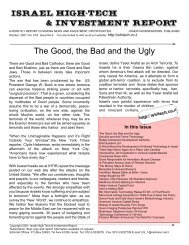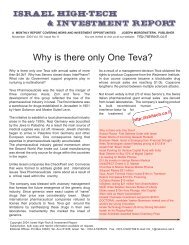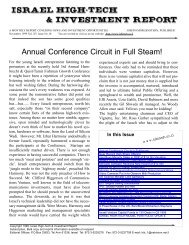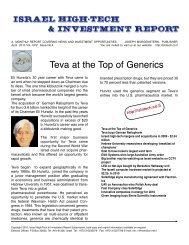Global Linkage - The Israel High Tech & Investment Report
Global Linkage - The Israel High Tech & Investment Report
Global Linkage - The Israel High Tech & Investment Report
You also want an ePaper? Increase the reach of your titles
YUMPU automatically turns print PDFs into web optimized ePapers that Google loves.
Teichberg and his colleagues had provided clear<br />
evidence of the very strong brain neuroprotection<br />
that oxolacetate (a chemical similar to GOT)<br />
afforded rats exposed to a head trauma.<br />
Two new studies – conducted by Fransisco Campos<br />
and others from the lab of Prof. Jose Castillo<br />
in the University of Santiago de Compostela,<br />
Spain – now provide a definitive demonstration<br />
of Teichberg’s results. In the first, the scientists<br />
conclusively showed that oxoloacetate injected<br />
into rats with stroke-like brain injuries reduces glutamate<br />
levels both in the blood and in the affected<br />
brain region, while significantly lessening both<br />
cell death and the swelling that can accompany<br />
stroke. In the second, a team of neurologists in<br />
two different hospitals checked the levels of glutamate<br />
and GOT in several hundred stroke victims<br />
who were admitted to their hospitals. <strong>The</strong>y found<br />
that the most significant predictor of the prognosis<br />
– how well they would recover at three months<br />
and how much brain damage they would suffer<br />
– was the levels of these two substances. <strong>High</strong><br />
glutamate levels correlated with a poor outcome,<br />
high GOT levels with a better one.<br />
<strong>The</strong> overall implication of these two papers is<br />
that administering GOT might improve a patient’s<br />
chances of recovering, as well as speeding up the<br />
process. In addition to stroke and head trauma,<br />
a number of diseases are characterized by an<br />
accumulation of glutamate in the brain, including<br />
Alzheimer’s disease, Parkinson, multiple sclerosis,<br />
epilepsy, glaucoma, certain brain tumors and<br />
amyotrophic lateral sclerosis, and there is hope<br />
that, in the future, treatments to scavenge glutamate<br />
could relieve the symptoms and improve the<br />
outcomes for a number of neurological problems.<br />
Yeda, the technology transfer arm of the Weizmann<br />
Institute, holds a patent for this method.<br />
Low-cost, nanometer-sized drug developed by<br />
Hebrew U. and others holds promise for treatment<br />
of chronic diabetes and burn wounds<br />
A low cost, nanometer-sized drug to treat chronic<br />
wounds, such as diabetic foot ulcers or burns, has<br />
been developed by a group of scientists from the<br />
Hebrew University of Jerusalem, Harvard Medical<br />
6<br />
March 2011<br />
School and others in the U.S. and Japan.<br />
Diabetes is a rapidly growing medical problem<br />
affecting close to 3 percent of the world’s population.<br />
Poor blood circulation arising from diabetes<br />
often results in skin wounds which do not heal,<br />
causing pain, infection and at times amputation<br />
of limbs.<br />
Several proteins, called growth factors, have<br />
been found to speed up the healing process,<br />
however purifying these growth factor proteins is<br />
very expensive, and they do not last long on the<br />
injured site.<br />
Now, scientists at the Hebrew University and<br />
Harvard involved in the project have used genetic<br />
engineering to produce a “robotic” growth factor<br />
protein that responds to temperature. Increasing<br />
the temperature causes dozens of these proteins<br />
to fold together into a nanoparticle that is more<br />
than 200 times smaller than a single hair.<br />
This behavior greatly simplifies protein purification,<br />
making it very inexpensive to produce. It also<br />
enables the growth factor to be confined and to<br />
remain at the burn or wound site. <strong>The</strong> scientists<br />
refer to their discovery as robotic, since just as<br />
robots are machines that respond to their environment<br />
by carrying out a specific activity, so too this<br />
protein they have developed responds and reacts<br />
to heat.<br />
<strong>The</strong> experimental drug, which ha been developed<br />
by the research group as a topical ointment, has<br />
been patented and thus far has been used to treat<br />
chronic wounds in diabetic mice, dramatically<br />
increasing the healing rate. <strong>The</strong> goal is to proceed<br />
to human clinical trials at some future date<br />
after future tests and refinements.<br />
An article on the project has been published<br />
online in PNAS (Proceedings of the National<br />
Academy of Sciences of the US). <strong>The</strong> authors<br />
are Dr. Yaakov Nahmias, director of the Center<br />
for Bioengineering in the Service of Humanity<br />
at the Hebrew University of Jerusalem; Dr. Zaki












